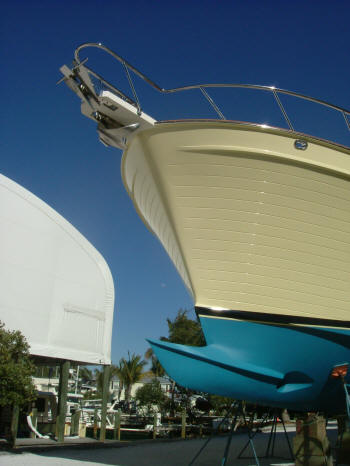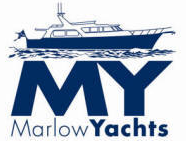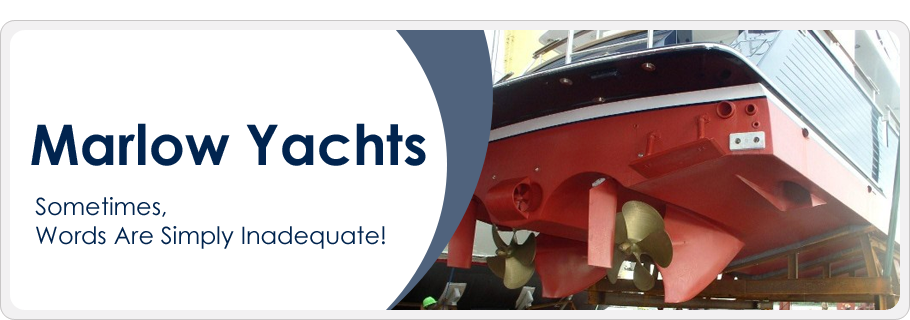| |
TECHNICAL INFO  Fuel Efficiency Fuel Efficiency
Our efforts in reacting to the probability of increased cost of fuel has been a relentless pursuit of technology resulting in yachts that are roughly twenty percent lighter than a single skin solid laminate of materials normally seen in “heavy” displacement yachts.
We embrace Kevlar and other highly engineered fabrics specifically designed to absorb the loading seen on board a yacht on any sea. We further refine that technology by infusing a SAN foam sandwich, resulting in an I-Beam like cross section of the hull laminate. To maximize the enhanced strength characteristics of this virtually bullet proof technology, we utilize modified epoxies that are matched to the strength of the individual fibers selected. It would be of little or no value to laminate these exotic high strength fabrics with a common polyester resin whose ultimate yield strength is only a fraction of the surrounding fabrics. In other words, the resin would fracture and fail long before the enormous strength of the fibers was utilized.
By embracing this advanced technology, we are able to reduce the weight per square foot of laminated area significantly, while producing a laminate far more rigid than a common single skin of roving, chopped strand mat and polyester resin. Were one to design a single skin laminate equal in strength to sandwich construction, the weight of the total laminated component would be several times that of cored construction utilizing today’s materials and technology. In lieu of attempting to build such an outrageously thick laminate with its attendant liabilities, most manufacturers reduce the unsupported panel size by elaborate stringers and framing to reinforce the physically weaker panel. This leads further into the rapidly escalating domino effect of more weight, less usable volume for a given size and a much more restrictive layout choice due to the need for additional framing, bulkheads and gussets, to say nothing of the loss of valuable sound and vibration dampening the sandwich construction brings.
Since fuel usage is directly tied to the mass that must be moved, all things being equal, it behooves us to reduce unnecessary weight wherever possible. In so doing, the canoe body draft can be and is reduced by simple immersion data; e.g. for each 64 lbs of additional weight on board, one cubic foot of immersed surface must be added to carry it.
Other benefits that are part and parcel of the quest for lighter structures are the automatic lowering of the center of gravity of the yacht. Weight above the center of gravity of a yacht could never be described as a benefit under any condition. Since the center of gravity on a well designed yacht fifty or so feet in length is typically only 3-5 feet above the design water line, a bit of simple mathematics shows us the detrimental effect of raising the center of gravity. In comparing a heavy solid laminate that has been unequivocally shown to be weaker for a given laminate schedule compared to a cored one, the superstructure with its large amount of framing can weigh up to 50% more than a modern cored structure. This additional weight must be carried by the propulsion system at higher horsepower and therefore additional fuel cost. To further evaluate the effect of older technology still in use, if the center of gravity is raised by only one foot, a very serious reduction in form stability results. Our own data suggests that much or all of the original economy achieved by the rounded sections can be lost if additional active stabilization is required for comfort, since active stabilizer fins work by throwing a large fin in counter to the water flow past the yacht. This motion adds significant drag to the displacement trawler, with the figure increasing significantly as the sea conditions increase.
Since the righting moment created by the combination of heavy superstructure and round sections is compromised, the normal tactic is to load the bilge with iron or lead to act as a counter to the heavier superstructure and topsides. Once again the domino effect rears its head, requiring more draft to support the ballast and more horsepower to keep it underway.
The subject of ballasting a yacht is one that can provoke a lively point-counterpoint by those fully versed in the dynamics of roll moment and the pendulum effect. An example of that argument can be found in the disastrous Fastnet race where more than one dozen fine sailors as crews on ocean racing yachts were lost due to the complete rollover of their vessels. It is interesting to read the findings of the investigative committee regarding the frequency and severity of the capsizes. The conclusions reached were that even though the yachts were fully ballasted, the loss of the mast by violent winds or wild gybes virtually guaranteed capsizes. The obvious inference being that despite the enormous ballast far below the center of gravity, without the stabilizing effect of the mast to act as the pendulum so to speak, the yachts were not as stable as if they were constructed without ballast. That evidence certainly gives one cause to carefully consider a heavy topside opposed by thousands of pounds of ballast. If one can simply reduce the weight of the topside while increasing its strength dramatically by more advanced engineering and materials, it would be difficult to make a plausible argument against doing so, other than economy.
 |
It is interesting to note the rapid move of US and other world government’s militaries to advanced composites or far lighter metals in superstructures of virtually all new ships. Reduced fuel costs, greater armament against enemy attack by utilizing higher technology and vastly increased comfort for the men and women who man the posts aboard. I am not aware of any new military designs underway today that embrace the full displacement theme. In fact quite the opposite, we see more and more Wave Piercer technology being introduced due to increased comfort, seaworthiness and economy of operation. I suspect that if heavy, deep and slow were viable concepts, our battle fleets would be made up of Bismarck like battleships typical of WW11 in lieu of the Arleigh Burke Frigates being launched routinely at Bath Iron Works |
On the subject of economy, while there can be no argument that a well designed full displacement cruiser can, even with the liabilities mentioned, achieve greater fuel economy in a very narrow speed range, compared to the best semi displacement designs, this economy is rapidly lost if the captain finds the lower speeds to be inadequate. A well designed full displacement cruiser will achieve outstanding economy at Speed/Length ratios of roughly 1.1 times the square root of the water line length. If we assume a 58’ yacht has a waterline length of 49’, we find a square root of seven. Multiplying 1.1 times seven yields a real cruising speed of 7.7 knots. Any attempt to increase that speed runs afoul of a rapidly increasing resistance curve that can easily triple fuel consumption for a modest one or two knot increase in speed. An attempt to exceed a Speed/Length ratio of more that about 1.34 times the square root of the waterline length ( 9.38 knots) causes the full displacement design try and climb its bow wave, which it cannot do due to laws of physics, no matter how much power is applied. Even at S/L ratios of 1.25, a very substantial fuel penalty is incurred.
Considering all the above and numerous other factors such as the apparent shortage of leisure time our modern lifestyles have afforded us, it is our opinion that a more middle of the road design is a better choice. By careful design of the underwater appendages and canoe body shape, together with a meaningful weight study and advanced construction techniques, we can achieve fuel economy remarkably close to the full displacement design if we choose to operate the vessel in Speed/Length ranges of 1.1 or thereabouts. If we are willing to pay the additional costs or time dictates, we also have the advantage of speeds in the twenty knot range with comparatively modest horsepower. If we are willing to pay even more, we can easily power the yacht with larger horsepower offerings, taking the speeds up into the thirty knot range. Beyond this general area, other design modifications should be considered, as the resistance curve of the semi displacement hull for we have designed becomes less efficient compared to a flatter, more “hard” section shaped yacht.
In weighing all these factors and carefully considering the average number of hours the typical owner will use their yachts over a period of years, it is not difficult to see the time advantage versus relatively minor cost tradeoff that most have chosen.
What will the future bring?
In our view, the increased cost of fuel coupled with the unlikely luxury of more time will cause slight adjustments to current hull design resulting in reduced skin friction to enhance a yacht’s “slipperiness” through the water. A softening of the chines will provide some of this gain with relatively minor reduction in inherent stability. Further technological gains in structural strength for a given weight will allow the reduction of waterline beam, providing still more gains. Engine manufacturers will join the fray by continuing to improve B.S.F.C.
Development of alternative methods of electricity production will reduce the required fuel to produce a Kilowatt of energy, driving the cost down even more.

|
|
|
|

